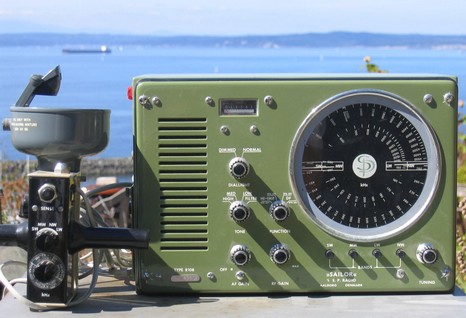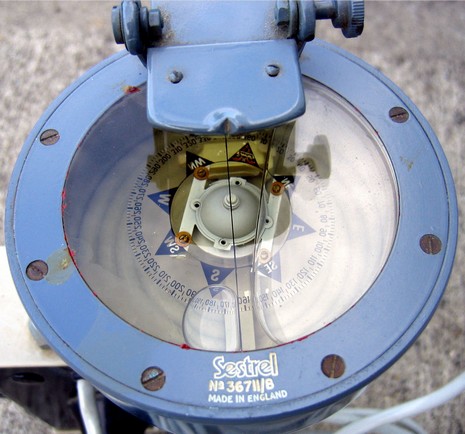Sailor Receiver/RDF, elephant proof

On a day when it’s hard to avoid heavy memories of 9/11/2001, it’s a bit of relief to go back much further. I remember these bullet proof Sailor receiver/RDF sets from some of the higher end sailboats I delivered in the 80’s. This particular unit belongs to panbote Gary Wood who was kind enough to answer my call for old electronics and to haul this knobby beauty out of his garage and photograph it, bigger here, with Puget Sound in the background. He’s had it for awhile, having:
“…bought it new for installation on our Wauquiez Hood 38, delivered in France in 1981. At that time, RDF was state of the art technology. Sat Nav hadn’t arrived, and Loran-C did not yet work in the English Channel and North Sea. I used it to find Heligoland in the middle of the night, an island in the North Sea about 40 miles from Cuxhaven, Germany. Other than that, it was great for listening to the BBC and to hear, but not talk to, SSB communications. We were in the Mediterranean a year later, and bought a Si-Tex Loran C. It was the size of a large loaf of bread, and it cost $1,500. But we knew where we were all the time! GPS has certainly changed all of this.”
Gary also reminded me that the 80’s ads for this radio featured an elephant standing on it. Rugged! The Sailor brand is still around, incidentally, but now, as part of Thrane & Thrane, the gear is pretty much solely focused on commercial ships.
PS. The comments reveal that some Panbo young’uns are baffled by the gray gadget at left in the picture (top down view below). Pardon me for not explaining better! Kids, it’s a hand bearing magnetic compass—hence the dampening fluid (which it needs desperately) requirements—with the Sailor’s directional antenna and remote controls attached. The odd doodad at the top is a mirrored magnifying prism so you could read the compass card as you swung the whole device at arm’s length, seeking the maximum signal from a radio beacon (probably through earphones). Or you could just use it like a regular, if bulky, hand bearing compass without RDF turned on.














Pardon my asking, but I’m unfamiliar with this; what is the metal cup asking for a alcohol-water mixture for?
So why exactly do you add alcohol to an RDF unit? What don’t I get? (Look at the larger picture, upper left hand label on grey thing.)
The Sestrel Radiant Handheld Bearing compass (as pictured attached to the RDF antenna) is the finest instrument of its type. They have a NATO approval number and could (still can?) be found on the bridge of all NATO warships. As well, yachting notables such as Chichester used one regularly.
I’ve owned one for over twenty years and it has provided great service. It’s the only bearing compass I’ve used that had a three bearing fix consistently cross on a point rather than form a “cocked hat”.
The instrument is still made and can be had from SIRS Navigation in the UK. The firm’s service is superb. See
http://www.sirs.co.uk/marine.htm
The compass is on of the few (only?) compasses certified to be used as a reference when swinging the compasses found on commercial aircraft.
I have the matching Sailor VHF sitting in my boat right now. It’s working, and part of me wants to keep it, but still. It’s a small boat, and could certianly use the freed-up space for something else, like say, a spare berth.
I have the exact same radio but have no idea what to do with it. It came with the boat I bought.
Dear Bob Bateman , and others Sailors owners !
No one use anymore RDF . Yet but theses Sailors still are wonderfull AM radio receivers .
What you can listen with , specially in LW , you can’t get it with thoses Digital receivers
FAZLI from ISTANBUL
I am still looking for the old SailorR109 and the directionfinder.
Somebody prepared to sell it?
Mail me please.l
I can’t believe that no-one has called you out on this 🙂
The RDF is used to find the MINIMUM signal when the unit is pointed towards (or away) from the radio station.
My Sailor saved me in 1976 in the Gulf of Papua. Sailing from Port Moresby to Bramble Cay got pushed north in a bad blow. Found myself gliding along in 6’ of silt. Got a quick sun line with the sextant and them able to null Radio Daru for a fix, of sorts. Found Bramble Cay several hours later and the Torres Straights to Darwin. Still thank my lucky stars the Sailor and Sestrel handheld were on board. Nice photos of a good friend.
have a sp radio hand bearing compass / a sailor d.f. unit type 46b mountson top of compass . I don’t know anything about this help nancy
Squeeze the antenna in to fit on top of compass. Tune your radio to the station you’re df’ing. adjust gain and sensitivity on the radio to most sensitive levels for reception. The point the compass toward the station and adjust the tuning knob on the compass antenna for best signal reception. Then slowly turn the compass right then left, etc until you receive no signal ( that’s called the null ). Keep swinging the compass until you get no signal and make note of the compass reading in degrees. On a chart adjust that compass reading for east or west longitude to convert to a true bearing and plot it on the chart with a line (in pencil).
Use another bearing either from the radio or sextant or however, plot it true on the chart, and where the two cross is roughly where you are. A three plot is better than two. Remember also that you do null is either to OR from the station, so make sure you’re pointed in the right direction. Good luck, Capt Mike